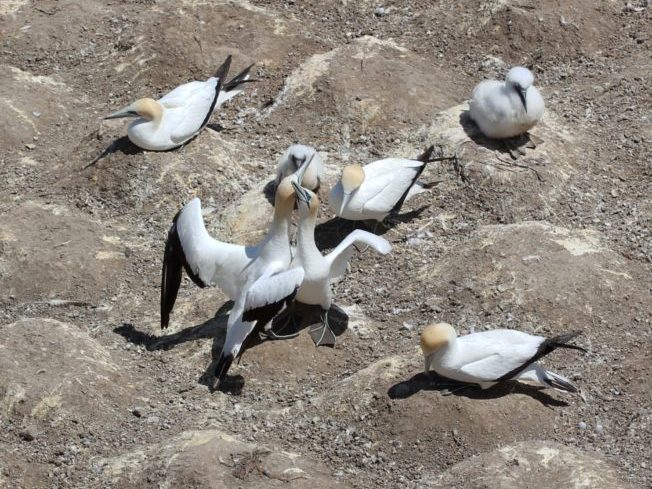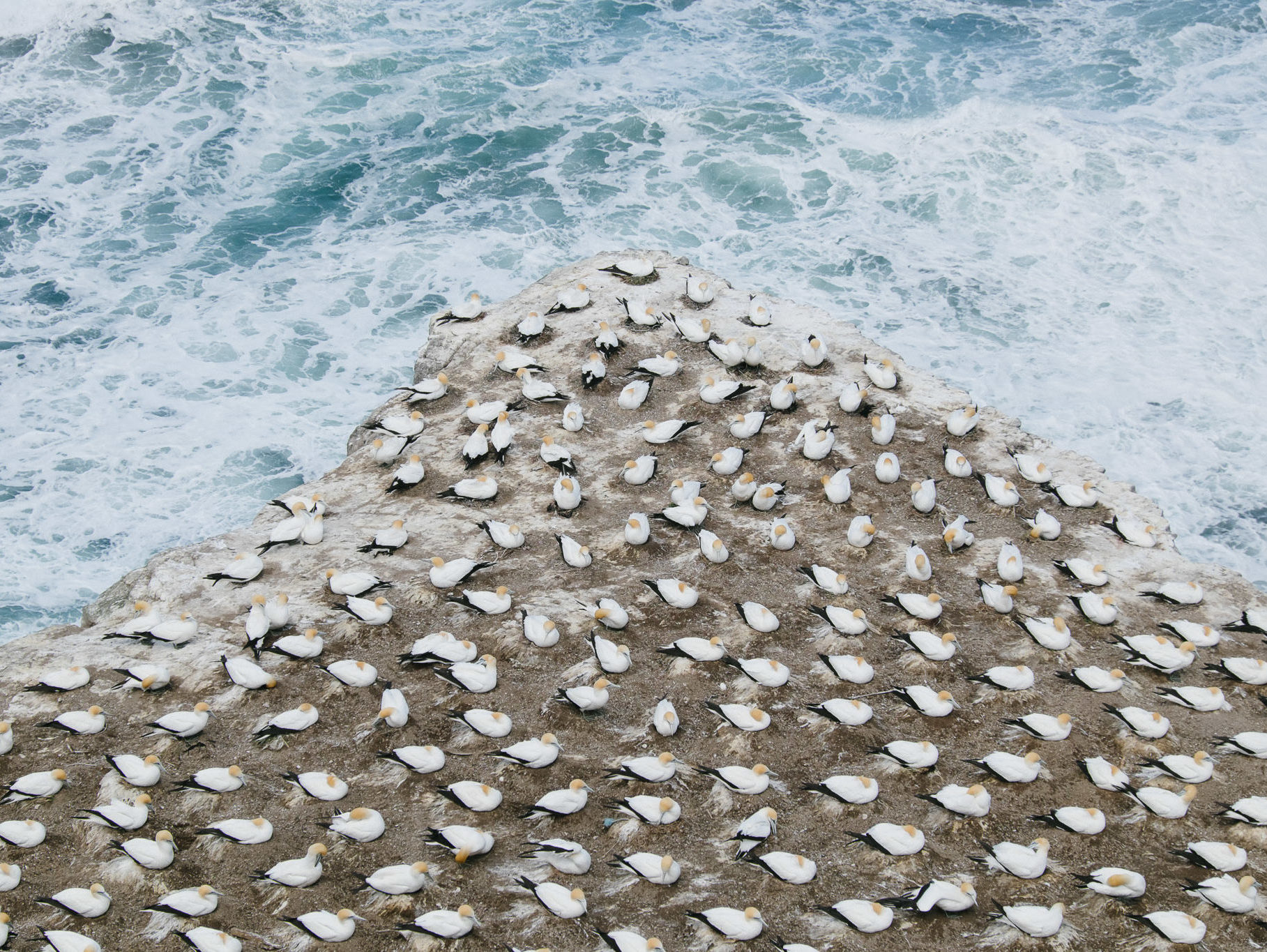Even been stung by a badly executed bellyflop? Then imagine the impact as a diving tākapu (gannet) hits the water in a perfectly executed dive. Tākapu can plunge 20-30 metres into the ocean, hitting the water at speeds of up to 145 km per hour. Just before impact they stretch their wings fully backwards and inflatable air sacks beneath the skin on the lower neck and breast absorb the shock of the high-speed entry. No bellyflops for them.

In shallower water gannets adjust their fishing technique so that they dive at an angle and they can dive from as low as 1 to 2 metres above the surface to forage in water less than 3 metres deep.
The tākapu or Australasian gannet is native to Aotearoa, but not endemic. As its name implies, it’s also found in Australia. Numbers of the birds are much higher in New Zealand, however, with a mere 13% of the population breeding in Australia.
There were an estimated 46,000 gannet pairs breeding in New Zealand back in 1980-1981 and numbers are reported to have increased by about 2% per year since then. It’s no surprise then, that the tākapu’s conservation status is ‘Not Threatened’.
Australasian gannets nest in dense breeding colonies on the New Zealand mainland and coastal rocks and islands, as well as off south-east Australia and Tasmania. Although they can be seen occasionally from most places along the New Zealand coast, most gannetries are situated off the North Island. The largest mainland gannetry is at Cape Kidnappers, in Hawke’s Bay, with around 5,000 breeding pairs.
The Cape Kidnappers colony is thought to have been settled around 1850, with 100 pairs reported in 1885. The Cape now accommodates over 20,000 gannets at peak time, spread over four main nesting sites – the Plateau, Saddle, Whalebone Reef and Black Reef colonies. Other mainland breeding sites include Muriwai and Farewell Spit.
The breeding season begins in July, when birds first return to the gannetries. Males arrive earlier than females and re-occupy or establish and defend a nest, retrieving nesting material like brown algae from the shallows to build the nest. The nest is constructed just beyond the pecking range of neighbours and during incubation the sitting bird’s poo cements and consolidates the nest structure.

The Cape Kidnappers colony is thought to have been settled around 1850, with 100 pairs reported in 1885. The Cape now accommodates over 20,000 gannets at peak time, spread over four main nesting sites – the Plateau, Saddle, Whalebone Reef and Black Reef colonies. Other mainland breeding sites include Muriwai and Farewell Spit.
The breeding season begins in July, when birds first return to the gannetries. Males arrive earlier than females and re-occupy or establish and defend a nest, retrieving nesting material like brown algae from the shallows to build the nest. The nest is constructed just beyond the pecking range of neighbours and during incubation the sitting bird’s poo cements and consolidates the nest structure.
Tākapu often breed with the same partner over consecutive seasons and some birds mate for life. Gannet divorces do occur, though.
Gannets are enthusiastic communicators! Characteristic behaviours at breeding colonies include mutual bill fencing and bowing of mates at the nest, the territorial headshake and bow at the nesting site, and sky-pointing as an indication of the intention to take flight.
A single egg is laid. Both the male and female incubate the egg in turn with the webs of both feet placed over the egg although towards the end of the incubation period of 42–44 days the egg is transferred to the top of the feet. This method of incubation means that tākapu can only successfully incubate a single egg. They later brood the chick on the top of their feet as well.
Newly hatched chicks are featherless and have black skin. Their eyes open at 2–3 days of age and by two weeks old they’re covered with white down. Feeds are delivered by both parents as incomplete regurgitations, which the chick receives by pushing its bill into the parents’ throats.
Chicks fledge in March-April and the New Zealand-hatched fledglings then embark on their big, trans-Tasman OE. It’s a perilous trip – taken without parental guidance – which typically only about 30% of fledglings survive. They fly directly to Australia, taking 6-15 days or longer, and may rest on the water to regain their strength but probably don’t feed en route.
Young birds typically don’t return until their third year, when they come back to their home colony to breed. For the rest of their lives they remain in New Zealand waters.
Although often treated as one species (Morus bassanus), the Australasian gannet is actually considered a ‘super-species’ made up of three gannet species that are closely related: with subspecies M. b. serrator for the Australasian gannet, M. b. bassanus for the northern gannet, and M. b. capensis for the Cape gannet.
Some local differences in foraging behaviour have also been recorded: Australasian gannets at Farewell Spit mainly forage on coastal fish in water depths of less than 50 metres, while those at Cape Kidnappers hunt more oceanic fish at water depths exceeding that.
School fish (anchovy, pilchard, yellow-eyed mullet etc) and small squid are their main source of food. Gannets can seize fish 10 metres underwater during their spectacular dives and while small fish are swallowed where they are taken, larger specimens are carried back to the surface for eating.

Traditionally, Māori were reported to have harvested young gannets for food, visiting Gannet Island (19 kilometres offshore from Kawhia) in March. The white feathers of adult gannets were used to adorn canoes and were worn by important members of the community. The bones were made into tools to apply facial moko (tattoos).
School fish (anchovy, pilchard, yellow-eyed mullet etc) and small squid are their main source of food. Gannets can seize fish 10 metres underwater during their spectacular dives and while small fish are swallowed where they are taken, larger specimens are carried back to the surface for eating.
Traditionally, Māori were reported to have harvested young gannets for food, visiting Gannet Island (19 kilometres offshore from Kawhia) in March. The white feathers of adult gannets were used to adorn canoes and were worn by important members of the community. The bones were made into tools to apply facial moko (tattoos).
Europeans once found tākapu good eating too – from the very earliest days of Aotearoa’s exploration.
On Captain Cook’s first voyage, the Endeavour’s crew shot three gannets off Three Kings Islands in New Zealand waters on 24 December 1769. Christmas dinner the next day was ‘goose pie’.
The incident is described in Sir Joseph Banks’ diary: “24th December 1769. Land in sight. An island or rather several small ones, most probably the Three Kings. From a boat they killed several gannets or solan geese, so like European ones that they are hardly distinguishable from them. As it was the humour of the ship to keep Christmas in the old–fashioned way, it was resolved to make goose–pie for tomorrow’s dinner.
“25th, Christmas Day: Our goose pie was eaten with great approbation; in the evening all hands were as drunk as our forefathers used to be upon like occasions.”
Gannets live for over 25 years. The full extent of their ocean wandering remains currently unknown, but some impressively distant sightings have been reported. Far-wandering gannets are occasional visitors to Marion Island and the Crozet Islands in the southern Indian Ocean and have even reached South Africa where they have interbred with Cape gannets.
Gannets aren’t just sticking to their traditional colonies for breeding, either.
On the South Island, gannets began breeding at the end of Farewell Spit in 1983, in an area known as Shellbanks—a 2 metre high area of shells and driftwood interspersed with low vegetation: marram, sea rocket, velvety nightshade and sowthistle. Strong winds allow gannets to take off vertically most of the time and local food supply is thought to have increased with the decline in commercial fishing in nearby Golden and Tasman Bays. The breeding area is cut off from the mainland by high tides, but can be badly impacted by storms. It has reportedly grown by around 11% per year, reaching an estimated 3,900 pairs in 2011.
Decoys have also been used successfully to persuade gannets to form a new colony.
Gannets established a mainland colony on Young Nick’s Head near Gisborne, after decoys of nesting birds and pre-recorded calls were broadcast to passing gannets in September 2008. Successful breeding was recorded at the site from the 2010–11 breeding season onwards.
A similar effort to establish a colony on Mana Island was less successful. It led to the arrival of a single gannet, dubbed Nigel “no mates”, who lived alone among the 80 decoys for several years until he was found dead in February 2018. In summer 2018, three more gannets arrived at the site – sadly too late for the lonely Nigel.

